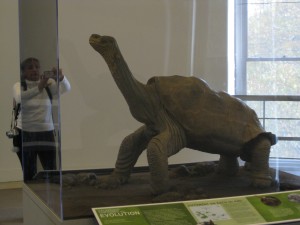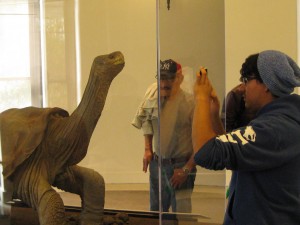|
|
George? Who were you George?
I’m standing beside a plexiglass vitrine at the American Museum of Natural History. In it are the taxidermied remains of George, the last Pinta Island Galapagos tortoise, who died suddenly on June 24th 2012, of so called ‘natural causes.’ At the time of his death, George was estimated to be about 100 years old – a spring chicken by tortoise standards, and sadly he passed away without carrying on his illustrious line. All other members of his Chelonoidis nigra abingdoni subspecies predeceased him, their once considerable numbers decimated by passing sailors who hunted them down as easy to catch and easy to store meat that could be kept alive in the holds of their ships for months. The few Pinta tortoises the sailors missed mostly starved to death after goats got introduced to Pinta in 1959, which then stripped away the vegetation they needed for food and cover. How George survived alone, until he was discovered when he came out of hiding in 1971, is still a bit of a mystery but he was soon shipped off to the Charles Darwin Research Station on nearby Santa Cruz in the hopes he might mate with females of a related subspecies and perhaps sire hybrid offspring to make situation of his genetic extinguishment a little less final. But it was not to be and George during the years of his confinement remained something of a sad curiosity, the embodiment of a ‘zombie species,’ still scrabbling around but already functionally extinct.
When George died in his enclosure, his head pointing poignantly in the direction of his drinking pool, his remains were promptly frozen and shipped off to the AMNH where he was set upon by a crack team of embalmers, who (it has to be said) did an amazing job making them look almost perky. The AMNH produced an informative video documenting the taxidermist’s macabre prestidigitations; the agonizing decision making of choosing the appropriate pose, getting the correct drape of his wrinkly skin right, the touchings up with paints and varnishes, the fastidious attention to detail neccessitating even splotches of authentic Galapagos dust to be daubed onto George’s eviscerated carapace.
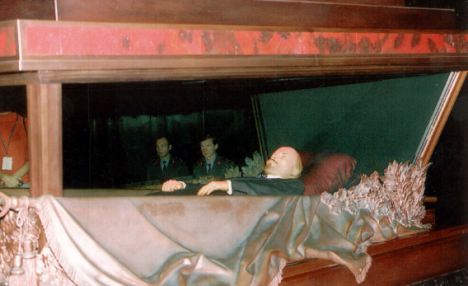 Lenin In his temporary mausoleum in the museum’s Astor Turret, George draws quite a crowd and he rather gives the impression of a reptilian Lenin, serene beneath the glass of his tomb, while crowds of supplicants stream by to pay their respects or merely snap a selfie or two while standing next to what was after all ‘the last of his kind.’ Other than a striking similarity in head shape, both lonesome George and Vladimir Ilyich shared the quality of becoming even more iconic after death, more laden with gravitas, their formaldehyde and wax-infused corpses the recipients of both veneration and revisionist history – George the last survivor of an imagined, prelapsarian, South Sea eden; Lenin the last ‘authentic’ Bolshevik.
The preservation of corpses, whether through taxidermy, embalming, or ritual mummification, seeks to reframe the life of the deceased into an idealized, one could say fetishized state; the gory circumstances of the death, the bleeding bullet holes torn through the flanks of the game animal before its final agonized collapse, the sunken flesh of the terminally ill patient after a long confinement, all cleverly obscured to make them look as they were in life, or rather, as they should have been according to the aesthetic agendas of their posthumous manipulators. Whether it be a valued hunting trophy or the body of a notable lying in state, what we are dealing with here is the grammar of propaganda and we should see it for what it is.
Lenin for instance appears as if he is rather beatifically following the whispers of his visitors from just under the lightest of naps, a fatherly figure enjoying a well-earned rest after finally putting things right with the world. Our tortoise George is displayed with an eagerly outstretched neck and custom-made eyes, beady and enthusiastic, as if he were about to embark on some pleasant chelonian journey, to a parallel universe perhaps where females of his kind still exist and the unpleasant finality of his extinction no longer needs to be contemplated. Though I won’t get into specifics of Lenin’s multifarious legacy, I’m not going out on a limb to say he’d have more than a little to account for if he ever woke up from that satin lined coffin of his. As for George, his carefully posed death puppet of a body has been spun by the AMNH and the Galapagos Conservancy, not as a symbol of our abject failure to preserve threatened fauna (which by some estimates we are losing at a rate of 140,000 species per year) but as an icon of high-minded wild life conservationism.
While I am all for a ‘glass half full’ outlook (and there have been some encouraging recent gains regarding Galapagos tortoise breeding), the AMNH’s attempt to transform poor dead George into a crowd-pleasing, feel good, story is one symptom of the museum’s larger initiative to revise their kill em’ and stuff em’ legacy into something more palatable to the contemporary metropolitan audience. It is of course laudable that the museum is now a ‘force for the good’ and active in world-wide efforts at conservation; a leader in the research of global biodiversity, but by papering over its extensive and enthusiastic record of ’collecting,’ that is to say, killing of scores of rare animals to create its famous, crowd-pleasing displays, we are deprived of an opportunity to learn from the institution’s history and to celebrate how far attitudes have generally come.
Let us look at the history of one of the AMNH’s iconic assets, the Akeley Hall of African Animals, a veritable temple of dioramas, each representing a major ecosystems of the continent. The centrepiece is an entire herd of elephants, massacred specifically for the display and arranged on a plinth what is described as an ‘alarm formation.’ Among them are a mother and calf shot by none other than Theodore Roosevelt and his son Kermit, who were actually over in Africa shooting elephants for AMNH’s rival, the Smithsonian but they generously bagged a couple of extra for their friends in New York, who after all needed a lot of them for their imposing composition and anyway, one gets the impression they were kind of on a roll. Even by the standards of the early 20th century, there would have been little scientific justification for this carnage and the herd of elephants frozen in mid outrage had a lot more to do with creating a spectacle than advancing any frontiers of zoological knowledge. These days we might more rightly regard this abomination as a reminder of the cruelty, barbarism and entitlement of the self-styled Great White Hunters of times gone by, a regrettable monument to what happens when colonialist privilege meets excess testosterone. And yet the AMNH makes no obvious effort to explicate or contextualize any of this. Their messaging to museum-going children is still that: ‘dead elephants are cool!’
The bulk of the hall is taken up by the dioramas proper, exquisitely painted tromp-l’oeil backdrops of arid, acacia studded plains and seething, hyper-vegetated rain forests in front of which naturalistic groupings of dead animals have been placed – rhinos wallowing in mud, apes clinging to jungly vines with adorable infants suckling at their breasts, antelopes of all shapes and sizes, big cats, giraffes, and just about any other creature one might expect to be found prowling, galloping or climbing through the idealized environs of a primeval Africa.
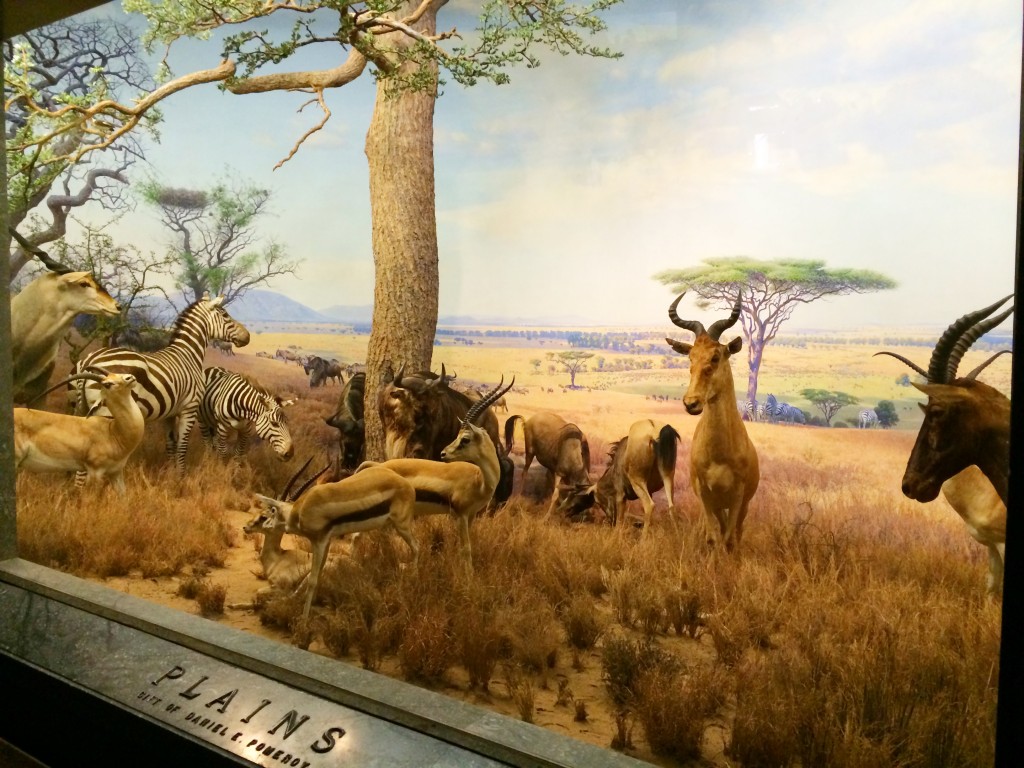
What the museum consciously underplays here is that these beguiling displays celebrate not only Africa’s once manifold biodiversity, but an entirely different aesthetic–a competitive materialism on the part of First World collectors, who in their fetishization of the exotic, spent considerable sums tracking down and killing some of the rarest, most elusive creatures on the planet to bring back as publicly exhibited trophies (let’s call them what they are) and to not so subtly underscore the power relationship between American empire and what was even then an increasingly subjugated global ’wild,’ a disappearing frontier of primeval ecosystems in the midst of colonialist exploitation. The dioramas, with their illusion of intimacy exist within the dissonance of us thinking that somewhere out there is still the possibility of an Eden while at the same time knowing that what is in front of us is an arrangement of dead skins propped up on armatures of wood wool and mothballs.
The not so subtle message of the AMNH’s dioramas is:
’ Nothing is beyond the reach of our guns,’
(or perhaps:)
‘To the victor – the spoils!’
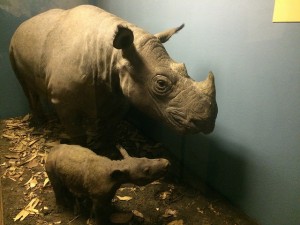 Sumatran Rhinos By the time the museum’s Hall of Asian Animals was being set up by Colonel John Faunthorpe and Arthur Vernay, a wealthy, British-born, New York antiques dealer, some animals such as the Sumatran rhinoceros and Asiatic lion were already going extinct in their native habitats and much was made of the lengths Vernay had to go through, the many appeals and entreaties he had to make to get the hunting permits needed to kill still more of them for his displays.
Was it all for a good cause, this science-minded collecting of critically endangered animals such as the mother Sumatran rhinoceros, shot along with her little calf for the edification of Gotham’s discerning, museum-going public? From a present day perspective, their dark little diorama seems particularly sad, a testament to a completionist obsession, the acquisition of rhinoceroses as if they were hockey cards or Royal Doulton figurines, regardless of the precariousness of the animals’ status in the wild; in fact spurred on by their tantalizing scarcity.
There is no doubt that in the past the demand from museums seeking rarities hastened the extinction of more than a few species and it would be helpful for our understanding of changing attitudes if the AMNH would take it upon themselves to highlight this dark side of their collection building. To be fair, this acquisitiveness was the norm for most natural history museums of the 19th and early 20th centuries, in both the public and private spheres. They weren’t always the bastions of wildlife conservation they now promote themselves as. While valuable taxonomic understanding can indeed be gleaned from specimens killed in the field, the slaughter of whole herds of elephants and entire rookeries of seabirds – even the nestlings peeled from their delicate skins to be stuffed and varnished– could never have been justified as ‘science’ even by the standards of the day. These are circus sideshows we should rightly view them as archaic, even vulgar. Though the Halls of African and Asian animals can perhaps be reconsidered as historic monuments to the quaint but also cruel attitudes of a bygone age, the museum’s media hoopla around their taxidermification of poor, dead George, seems anachronistic to say the least. We learn very little from a dead Galapagos tortoise, no matter how cleverly he is mounted. George now exists as an art-directed ‘thing,’ optimized to look the way we expect him to and no longer a ‘being,’ with his own agency and life world. We screwed up and he went extinct. No amount of paint and fibreglass will change that tragic fact.
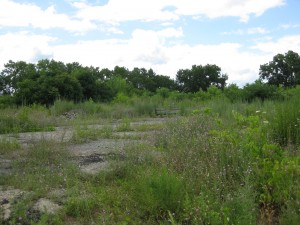 North Troy NY brownfield savanna
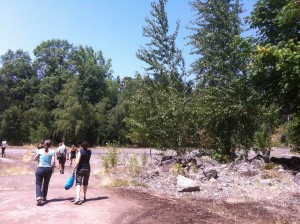 safari into the Williamette Cove brownfields
Those of who call ourselves ‘environmentalists’ have a tendency to imagine a prelapsarian wilderness that once was pristine and then became progressively defiled and diminished through the carelessness of humankind. But the earth had been through many environmental catastrophes long before we came along– though this doesn’t exactly excuse us from our manifold sins. The infamous Chixculub asteroid impact suddenly ended the long reign of the dinosaurs and the more insidious yet equally catastrophic evolution of photosynthesis deep within the cells of certain cyanobacteria contaminated the earth’s early biosphere with oxygen– a fatal poison to the majority of organisms present at the time, resulting in what is now known as the oxygen catastrophe, a mass die-off of the earth’s biodiversity and a climate change event that froze the planet in the longest snowball earth episode in geologic history.
What is unique in the present (Anthropocenic) moment is that we know we are causing a massive and likely suicidal ecological crisis and yet choose not to do anything about it. Here we are at the tail end of 2014 with atmospheric CO2 levels higher than they’ve been for 800,000 years and the 6th mass extinction accelerating to the point where the earth has lost half of its wildlife species in the past 40 years. Political leaders, particularly those of oil rich countries like my native Canada either willfully ignore the scientific consensus or in the most egregious cases, (again Canada), actively censor the findings of scientists and even weather forecasters. Because a little knowledge can be a dangerous thing. Or is it?
In a recent video, Žižek makes the perhaps startling case that there is considerable poetry in our present situation, that is to say, our disavowal, our state of knowing that something is true and yet acting as if it wasn’t. He argues that to “truly love the world, we must love its imperfections,” including, presumably, the ones for which we are directly responsible. “In trash,” he declares “is the true love of the world,” a sentiment similarly observed by a Zen priest in the masterful little documentary, Tokyo Waka, which explores the world of Tokyo’s ubiquitous and trash loving crows. To be more precise the priest observes: “In trash is the residue of desire,” a sentiment perhaps less direct but still elevating garbage to a kind of reified affection.
To follow that logic, when an entire landscape becomes trashed, it should be particularly worthy of our love and it was in this spirit that I embarked upon my summer explorations…
But first some background: The Superfund was originally set up in the America in 1980 to identify and facilitate the cleaning up of the country’s most hazardous waste sites. In theory this might have created sufficient funding and legislative willpower to deal with this dangerous and unhealthy problem but between partisan politics and bureaucratic ineptitude, implementation fell far short of what was needed.
Though most people would want steer clear of toxic wastelands, I wanted to see if there were any adaptive ecological processes operating there that might be transforming these zones of exclusion into useable habitats. I had the strong sense that conventional ecologists and environmentalists might be missing something very important, that nature was capable of doing an end run around our destruction, if only we would get out of the way. My summer safari took me to sites on both sides of the continent–Troy, NY and Portland, Oregon–and what I observed there gave me some hope and insight into nature’s surprising ability to colonize the messes we have left behind.
I was invited to Troy by my pal Kathy High for a collaborative investigation into the area’s extensive brownfields. Once known as the ‘collar city’ for its shirt, collar and textile production, Troy is considered the birthplace (and graveyard?) of the American industrial revolution. A fortuitous confluence of rivers made it possible for early factories to harness abundant mechanical (and eventually hydroelectric) power as well as to cheaply transport products and raw materials. Like so much of America’s industrial heartland, the area has suffered from economic decline and many of its once thrumming factories lie in ruin in within highly contaminated terrain.
Some of the worst sites are situated along the banks of the picturesque Hudson River, which transitions here from tidal to freshwater, the end of a long estuary. Downstream, all of the Hudson is classed as a Superfund site because of extensive contamination by PCBs, a potent carcinogen, dumped for decades by the General Electric Corporation as a byproduct of manufacturing transformers and other electrical components. PCB’s are a persistent organic pollutant (POP) that bioaccumulate in the river’s fish, making many species unsafe to eat–including the reputedly delicious striped bass that spawns nearby at the junction of the Hudson and Mohawk rivers.
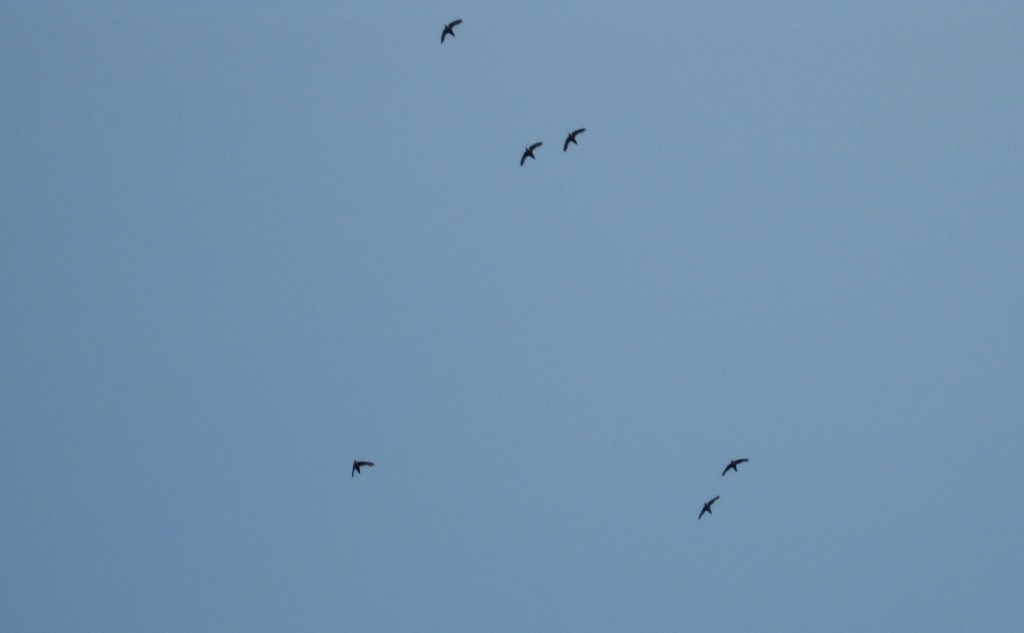 chimney swifts over North Troy Despite being a very degraded ecosystem Troy’s former industrial landsa are full of surprises. As part of a summer youth program, I led a ‘bio blitz’ of a community garden that had been established on a brownfield site near the Sanctuary for Independent Media. It wasn’t long before we found a magnificent stag beetle hiding in the rotting stump of an (invasive! exotic!) Ailanthus tree. High overhead, chimney swifts traced their invisible arabesques into the topaz air of the summer evening. This species, has long adapted to human presence and as indicated by its common name, makes its nests in disused chimneys. The chimney swift is a close relative of the Vaux’s swift, which puts up a spectacular display every evening as great clouds of the birds funnel into in a large chimney at the Chapman School in Portland, Oregon.
A local Troy resident told me she had recently found red-backed salamanders under debris in her backyard yard, situated quite near some of city’s most contaminated industrial sites, with nothing that might be deemed ‘intact’ woodland anywhere in the vicinity. With the sharp decline of amphibians worldwide, even in protected national parks, it might seem surprising to find them surviving in such anthropogenically disturbed habitats but this is consistent with findings in the UK where rare newts and other amphibians as well as lizards, slow-worms and grass snakes make their last stands in these unprepossessing environs, among the trash, eroding pavements and ruined buildings. In fact brownfields turn out to be far more suitable habitat for these delicate little creatures than is the intensively managed agricultural landscape that has obliterated large tracts of Europes’s biologically diverse ‘Kulturlandschaft’.
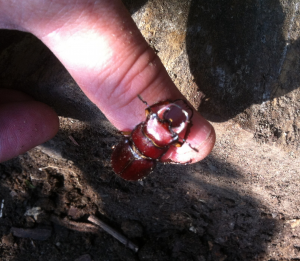 stag beetle in Ailanthus stump At a Superfund site at the foot of Troy’s Ingalls Ave, I watched turkey vultures soar over an edenic looking mosaic of meadowy expanses that have cloaked the heavily contaminated soil. These neo-savannahs are punctuated by lush groves–a botanical mosh pit of weedy natives like box elder, black locust and cottonwood mixed in with exotic Ailanthus and Paulownia. All of this is gloriously unmanaged, left to its own rampancy, and though the species constituting this habitat are largely considered ‘invasive,’ they embody a new kind of ecological becoming, their novel juxtapositionings and processes of succession–a ‘Nature 2.0′ in the making.
If we put aside our purist bias, we might celebrate brownfields as territories of regeneration and marvel at how they adapt to the disturbances and wastes we leave in our wake. One might even regard them as ‘wilderness’ of a certain kind as they are one of the few ecological realms we have let slip from our control–leaving them free to reconfigure themselves and follow independent trajectories of neo-evolution.
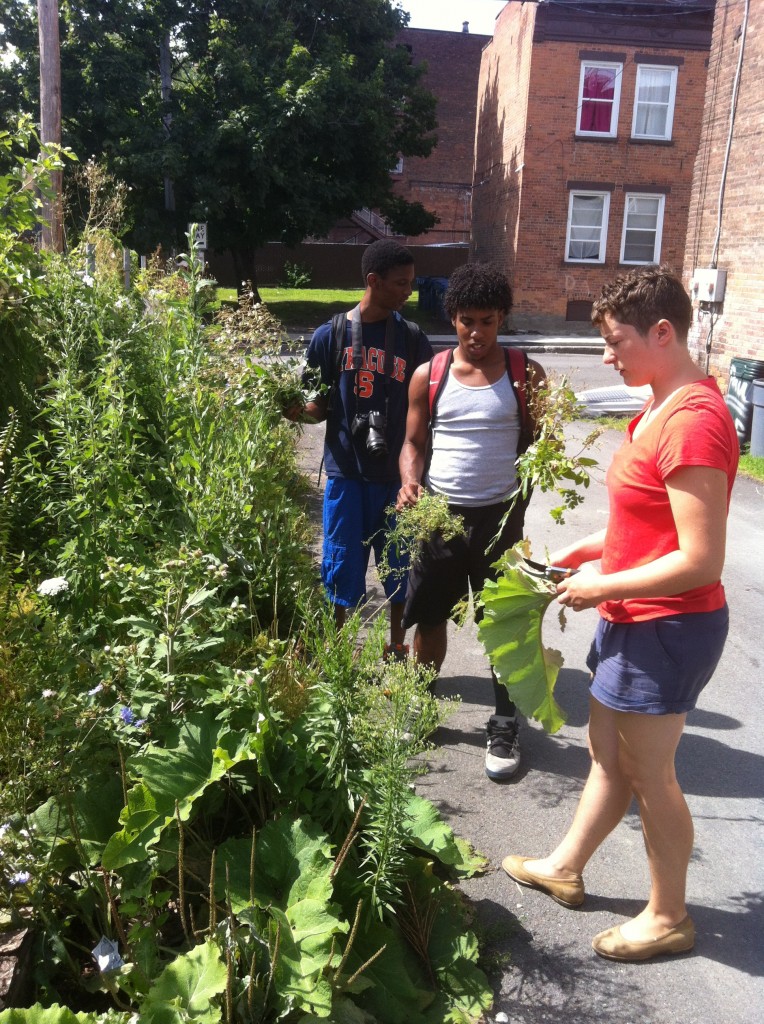 Troy NY’s future brownfield rangers The collapse of industry though, leaves more than just picturesque ruins and novel habitat in its wake. For human communities,‘Detroitization’ means decaying infrastructure, diminished economic opportunity and the adverse health effects of pervasive chemical contamination. If sufficiently de-toxified, these lands can be rehabilitated as perfectly reasonable urban nature parks (see my previous posting on Berlin’s Templehof airport) but the challenge is to do so without diminishing their often surprising biodiversity.
Troy might be an ideal location for a Brownfields National Park, where local youth could work as ‘brownfield rangers,’ leading tours of the area’s ecological and historical heritage as well as doing field studies and cataloging the species to be found there. Though this necessitates a change of perspective in what we North Americans typically think of as a ‘natural’ park experience, it is high time we open our minds to such opportunities. Brownfields are the future. Brownfields are us!
Over on the other side of the continent, I met up with artist Marina Zurkow in Portland, Oregon. Together, we led artistic incursions into a Superfund site on the edge of the Williamette River. We explored first by water, using a flotilla of kayaks peopled by an intrepid collection of individuals who responded to our call for participation in what (to the less adventurous) might have seemed an arcane enterprise. We conceived our expedition as a kind of group imagination exercise and christened it -“IF YOU SEE IT–BE IT!” in the spirit of the biosemiotician Jacob Von Uexküll, who did such groundbreaking research on the spatio-temporal worlds of animals, which he termed the ‘Umwelt.’ Aboard our tiny craft, we collectively tried to imagine/channel what it might have been like to navigate the contaminated and disturbed riparian environment from an animal’s point of view (water striders, otters, sturgeons, etc.) – inhabiting (in our mind’s eye) their biosemiotic state, ‘becoming’ them, as it were, in a collective thought exercise.
Marina’s long term plan is to construct a raft-like roving laboratory she calls the Floating Studio for Dark Ecology, on which artists and researchers ply the river, exploring its narratives of contamination and recovery as well as disseminating practices of contemplation and engagement between its human and non-human communities.
Our early evening voyage proved suitably anthropocenic: a bald eagle gliding through the shimmering cottonwoods of Ross Island–a section of river whose bed is being continually scoured by heavy gravel mining machinery–the blue tarp and scrap lumber bricolage of homeless encampments festooning the banks of the Williamette–the third world within the first world, the metabolic waste of neoliberal capitalism as it eats its way through our material reality.
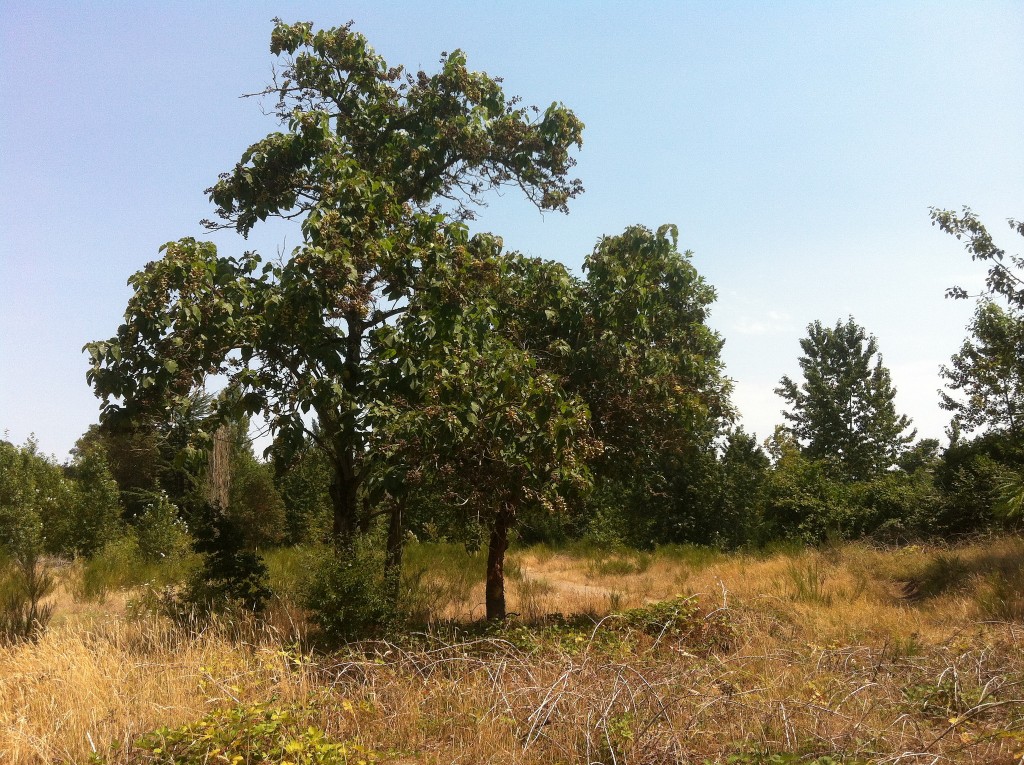 Neo-ecologies of Williamette Cove Once again there were fascinating and new ecological assemblage in these zones of dereliction and abandonment. Washed up on the industrial shore of a former shipyard–exquisite hydrozoans of a type I have never seen before:
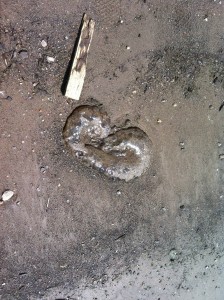 hydrozoan The brownfields of the former factory site at Williamette Cove, though dangerously contaminated with heavy metals, wood preservatives and organic pollutants, proved not so ‘brown’ after all and were resplendent with novel botanical groupings–neo-succession! Native species like Arbutus menziesii (Madrone) formed habitat groupings with such hardy exotics as Paulownia tomentosa (princess or empress Tree) and Crataegus monogyna (European hawthorn). It is thought the empress trees made their original landfall in North America via their fluffy seeds, once used as a packing material for porcelain and other fragile goods originating in China and Japan. A gust of wind and an open crate at the dockside and their botanical colonization of the continent would have been begun.
In addition to brownfield neo-ecologies there is a parallel and equally fascinating neo-geology emerging from the material detritus of our age. Mineralogically, these are mostly composites and conglomerates or pyrolized residues of industrial processes such as coke and slag, as well as ceramics that have been fired into the form of brick, tile and pipe, much of it broken up into rubble. This so-called ‘urbanite’ is dominated by concrete and ferro-cement in various states of decay and petrochemically based asphalt and asphalt concrete, widely used in paving.
Sometimes though, a geologic object occurs that is of more obscure though still clearly anthropogenic provenance. At Williamette Cove, we came upon an exquisite specimen–a fossil of sorts–consisting of a fused mass of ribbed metal fragments, the armouring of industrial electrical cable, set within a matrix of a more indeterminate material, which might have been partially incinerated plastic. Perhaps this mystery mineral was formed when some itinerant metal collector tried to salvage copper wire by throwing scrounged cable into a campfire to melt off its rubber insulation and loosen the metal cladding. I may never discover this exquisite object’s true origin and it might well become the topic of frenzied conjecture to some future archeologist, wondering what our experience was like as we drifted deeper into the fraught and turbulent horizon of our anthropocenic future.
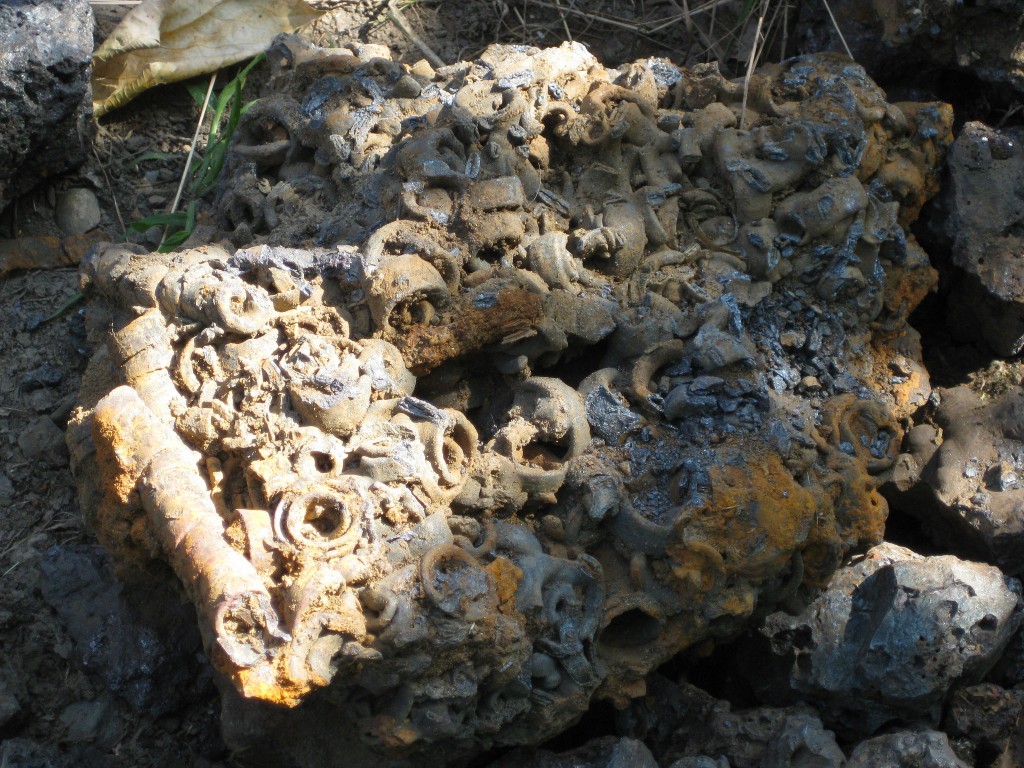 neo-geological form
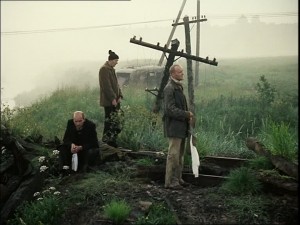 zone of alienation
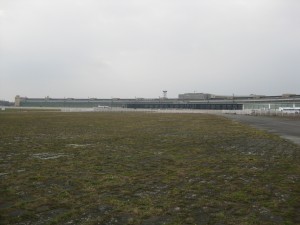 zone of regeneration
In Tarkovsky’s 1979 film Stalker, a mysterious guide leads a couple of characters known only as ‘the writer’ and the ‘professor’ into a post industrial ‘zone of alienation’ where it is promised one’s innermost wishes can be granted and where the rules of physics no longer apply. The ‘Zone’ is completely abject, a place of weeds, broken machinery and the ruins of factories and yet it is hauntingly beautiful in a way that is triggered (perhaps) by our deep yet unconscious familiarity with such landscapes –the places Walter Benjamin called the optical subconscious, the quotidian zones in which we are so fully at home we don’t even realize we live there.
These aren’t the iconic, aspirational landscapes of snow-capped mountains, palm fringed coral beaches and glittering urban skylines –the stuff of screen savers and photo murals in tacky restaurants, but rather the prosaic localities we continuously experience, perceiving them peripherally, from the corners of our eyes yet rarely explicitly acknowledging. The French term ‘terrain vague’ comes closest to the way these places feel and they might take the form of a trash-strewn railway embankment or an abandoned car park with rank vegetation coming up through the broken pavement or perhaps one of those forlorn, zones of contamination we refer to as brownfields, which have become the global hallmark of industrial decline.
I think back on my Amtrak journeys through the rust belt of America, marvelling at the Piranesian grandeur of once opulent railway stations left to crumble at the trackside, the ruined vaults now sheltering only birds which dart in and out of the shattered arrays of windows. The train keeps chugging lethargically (it is Amtrak after all, itself a symbol of decline in American technological ambition) through dour, neglected expanses, prosaic, ugly, endless –you can’t really call it ‘countryside’ exactly– but for the occasional scruffy woodlot and oily wetland which passes between the wrecking yards, quonset huts and derelict factories. This is (as Deleuze might call it) a ‘striated’ landscape that interleaves the decaying residue of a once prosperous age of material production with a resurgent, weedy nature –an ecology of discard, a ‘zone of alienation’ where anything might appear– a muddy field strewn with bone white shards of dishes and upturned toilet bowls, the twisted wreckage of a carnival rides left over from, what? A tornado? Perhaps, even–though I did not experience it–the fulfillment of one’s deepest wishes…
But is this not the state of the world as we all now know it? It’s the Anthropocene, baby, and collectively we’ve chewed up every inch of biosphere; extirpating, contaminating and cultivating ourselves into this, the global ‘Nature 2.0’ reality, where even the unfolding of weather and the chemistry of the oceans have become extensions, artifacts of human existence. So past the point of no return are we that we might as well discard nostalgic notions of ‘wilderness’ and adopt a new, Anthropocenic grammar, already envisioned by the likes of Žižek and Morton, which more aptly describes the hybridized, pervasively humanized environment in which we now live.
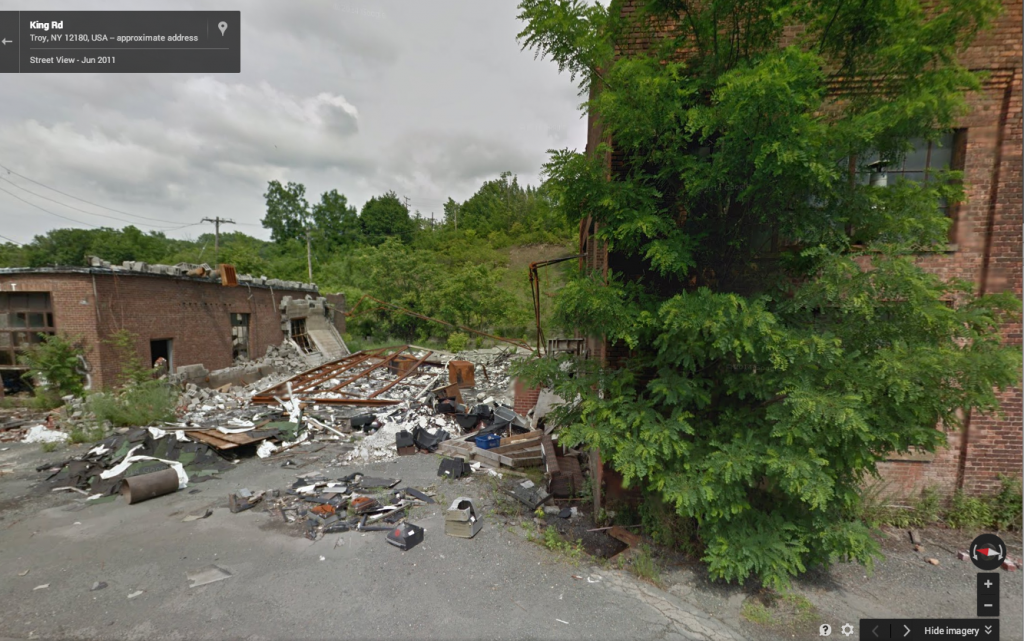 terrain vague Our planet has essentially become one, big ruderal ecology (from the Latin ‘rudus’ meaning rubble), characterized by the large-scale extinction of species–passenger pigeons, big cats, rhinos–as well as entire ecosystems–Madagascar, the Arctic, coral reefs. And yet there is a curious, parallel process of adaptive evolution occurring in the disturbance ecologies and debris fields (called anthromes) we leave in our wake.
At Chernobyl (one of the greatest ecological and social messes we have ever been responsible for, a byword for lethal, irreparable contamination and epic technological failure) some bird species–and by no means all of them, as many kinds there have significantly declined–but certain bird species seem to be surviving by evolving a tendency to produce more cancer-fighting antioxidants which help resist the effects of the pervasive radiation. Scientists are calling this “unnatural selection” and it is already driving evolutionary change.
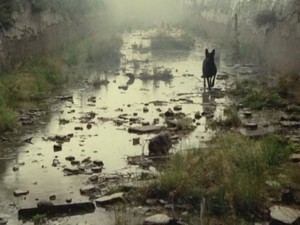 canid hyperorganism In much of eastern North America, the wolf was largely wiped out during European colonization but it has recently come back not as a wolf exactly, but a kind of hyperorganism–a three way hybrid between wolf, dog and coyote that pushes the boundaries of what it even means to be a species. With the precipitous decline of the ancestral wolf, an ‘eye of the needle’ effect ensued in which wolf genetics became more ‘soluble,’ more open to other singularities and contagions, a necessary precondition for the evolution of a new, protean canid, able to prosper in the niche now available for some canny predator able to exploit the pervasively humanized and ecologically degraded environment of second growth forest and exurban sprawl–the kind of places that are an anathema to the so-called ‘pure’ wolves of the primeval wilderness but which offer abundant prey resources of lawn-fed deer and genetically moronic pets. Enter the ‘Coywolf’ or Eastern coyote. They might be a product of ‘unnatural’ selection, but they sure are hungry!
Such novel recombining is occurring at a multi-species level too, with entirely new hyperecologies evolving as weedy, native species commingle with invasive exotics, all of them jostling and repositioning themselves into configurations that never would have existed ‘naturally’ but which now comprises recognizable and widespread landscapes of brownfield savannah and emergent, wasteland forest that are found throughout the world in pretty much any place we have exploited and then turned our back on. Many of these organisms are the hardy cosmopolitan nomads we are all used to seeing, such as tree of heaven (also known as the ’garbage palm’), black locust, pigeons and rats, but perhaps surprisingly these unprepossessing assemblages can support a diverse array of other species, some exceedingly rare, which hail from habitats like gravelly steam banks and dry heaths now largely obliterated from a hinterland dominated by chemical intensive farming and vast, ecologically sterile acreages of housing developments and big box stores.
In the UK, where humanized landscapes are particularly well studied, it is estimated that up to 15% of the nationally rare insects and spiders are dependent on brownfields for their survival as do several species of reptiles, orchids and other rare plants.
I was delighted last March to visit the grounds of the now disused Templehof Airport in Berlin, which as a result of citizen pressure has been set aside as a kind of publicly accessible ruderal ecology park. Here one is greeted by the incongruous site of windsurfers careening along miles of abandoned runways while skylarks hover high over vast swathes of tawny grassland, singing and establishing territory in their annual rite of spring.
Along with a surprising diversity of meadow dependent birds – wheatears, shrikes, whinchats and so on, 236 bee and wasp species have been recorded on the grounds, more than 40 of them endangered or near extinction, particularly those dependent on the open, sandy microhabitats that have all but vanished in the over-managed environs of the countryside.
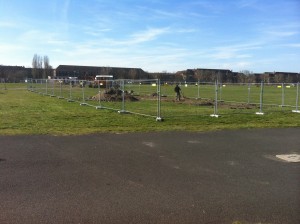 gestapo prison excavations
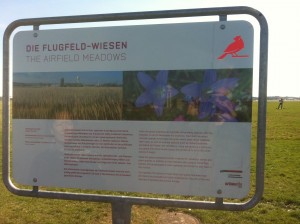 airfield meadows
This wonderful interleaving, this striation, this ‘to-ing and fro-ing’, between architectural ruin and ecological renewal is to my mind a tremendously optimistic model for the future of parks in general and for our appreciation of landscape as a whole and it is in promoting this aesthetic that Berlin is very much at the fore. The Templehof park doesn’t try to paper over its problematic Nazi past but lets us grapple with it by preserving the forbidding Fascist architecture and letting us watch archeological excavations of Gestapo prisons and slave labour camps taking place on on its grounds.
At the same time we are offered profound hope by witnessing innate processes of ecological and cultural regeneration get encouraged, not in an over-planned or commercialized way, but from the ground up, in a way that is distinct from the banal, generic late capitalist aesthetic that so frequently defines urban renewal initiatives elsewhere. By being leaving it alone, Templehof is able to renew itself.
Though the global ecological crisis is deep and inestimably tragic, we can perhaps allow ourselves to cautious celebrate the evolution of a new kind of nature, a ruderal nature, where kestrels soar across the heat haze of abandoned runways that are slowly becoming encrusted with lichens and grasses and where rare wild flowers can find a toehold among the rubble of some of history’s worst crimes against humanity. The sky is filled with the coloured sails of paragliders and a bumblebee is making its first foray into the vast warm vault of another spring.
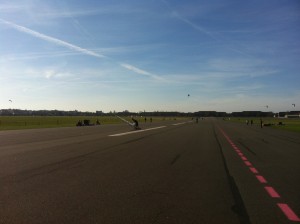 sailing the runways
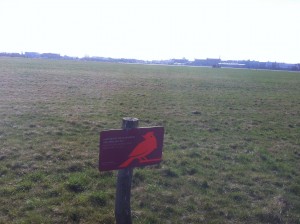 skylarks nest here
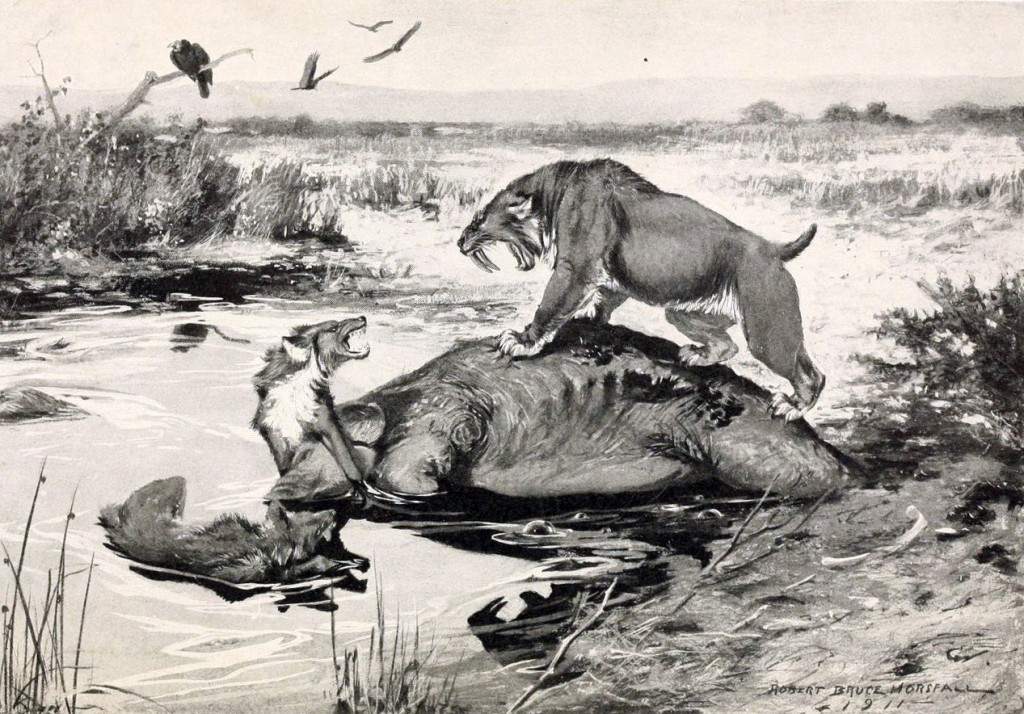 where it all went down… The great blue bowl of the California sky has doubtlessly presided over some strange affairs, but perhaps none is stranger than the serial cycle of entrapment and petrification that started around 38,000 years ago in a collection of deceptively limpid ponds in what is now a quiet park in downtown Los Angeles. After it rains here, the play of sunlight and clouds is mirrored on their lambent surfaces, beneath which lies a menacing secret: for what first might appear to be a refreshing pool in an arid terrain is only a thin film of water obscuring an abyss of sticky bitumen, which has been oozing steadily from petroleum-bearing rock formations deep beneath the earth.
These are the notorious La Brea Tar Pits and since the days of the Pleistocene their peculiar configuration has served as both death trap and mausoleum for thousands of creatures–great and small, thirsty and merely curious–who venture into them and get stuck in their viscous pitch. Like a giant version of the ‘cockroach motel,’ once they ‘check in’ they never ‘check out’ and indeed the thrashing and bellowing of trapped victims attracts predators, whose natural wariness proves no match for the promise of an easy meal, ensuring they too are quickly doomed after jumping in for the kill. And so for thousands of years, whole conglomerations, entire food chains of animals have met their ends here: predators and prey sinking down alongside each other, each creature naïvely repeating the fatal mistakes of its predecessor: sabre-toothed cats and Dire wolves, with fangs and claws sunk into the contorted bodies of mastodons and camels, all of them frozen in elemental struggle as if in some Classical frieze. Not even the carrion eaters escaped the gruesome fate. Outsized vultures, giant condors and hideous, meat-eating storks, wheeling and squabbling for landing rights on the bloated corpses and almost corpses, snagged themselves when a carelessly extended talon or trailing pinion made contact with the merciless tar, that pulled them in, flapping and screeching , never to fly again. As well as being deadly, the tar has miraculous powers of preservation. The seething, interconnected beds of bone that have accumulated there have kept scientists busy ever since they first started excavating back in the early 1900s. Many of the rich paleontological finds are on display at the adjacent George C. Page Museum.
When I was a boy in Toronto back in the early 1960s, a small piece of the La Brea Tar Pits was on display in a dusty diorama at the city’s Royal Ontario Museum. This was a few years before the ROM adopted the loathsome trend for ’interactivity’, which consigned much of the museum’s extensive palaeontology collection to back rooms, out of public view, and what we got instead was an ersatz mishmash of mood lighting, audio tape loops and fibreglass models of dinosaurs standing aura-less amid plastic palm trees. Anyway before all that stupidity, I remember how transfixed I was ‘just looking’ at the thing itself, without being told how to think about what was in front of me – the tea coloured skeleton of a sabre-toothed cat, its outsized canines filigreed with tiny age cracks, poised to stab the neck of a hapless ungulate (a proto-camel? an extinct horse?) which had already begun to sink. It was the futility of it I remember the most, that both animals died together in the same inescapable way, the first doomed by thirst (or bovine idiocy), the second by carnivorous savagery. And I knew this scenario was to play itself out again and again because it was elementally and inherently unavoidable. Presiding over the sad scene was a tromp-l’oeil painted backdrop of a clot of vultures, hanging like wind-ripped umbrellas in the branches of a skeletal tree, and in broad brush strokes, a distant herd of mammoths melting into the horizon.
When I finally, this spring, got to tour the La Brea tar pits firsthand, I couldn’t help but see them as a kind of trope for contemporary times.
LA is a strange enough place to begin with–its palm-studded freeways and rivers of twinkling windshields pouring into the heat haze of the hyper- illuminated horizon–a place at once banal and startling, the High Baroque of American drive-thru suburbia amid scintillating beaches flooded in a golden, Canaletto-esque light. There are people there, of a certain age, whose faces have been so surgically altered it is as if they’ve been sucked through a magic wind tunnel. The mismatch between their wrinkle-less heads and the sun-withered bodies is chimerical, as if bands of Surrealist ‘exquisite corpses’ had gone AWOL, pulling themselves off the canvases and walking around. Los Angeles is the very essence of the American Anthropocene and yet prehistory bubbles and belches everywhere just beneath the surface. The city sits astride a massive oil field, where serried ranks of mini malls and tract homes lie nestled in the napes of brown hills and rustling eucalyptus groves, the edges of which bleed into a kind of terrain vague of ponderously nodding pump jacks tirelessly sucking petroleum out of a deposit dating back to the Miocene– a geologic epoch already long gone by the time the first mammoths sank into the tar.
Wandering through the pleasant grounds of Hancock Park, the past becomes the present and one soon encounters a pair of giant, chocolate-coloured ground sloths, like outsized Easter confections, placid and dim-witted in expression, yet armed with menacing fore claws that could easily rip the face off almost any attacker. As late as 10,000 years ago, these ungainly beasts lumbered across what was a vast North American range – their remains having been found from the Yukon to Mexico. At La Brea, they were regular victims to the suffocating tar.
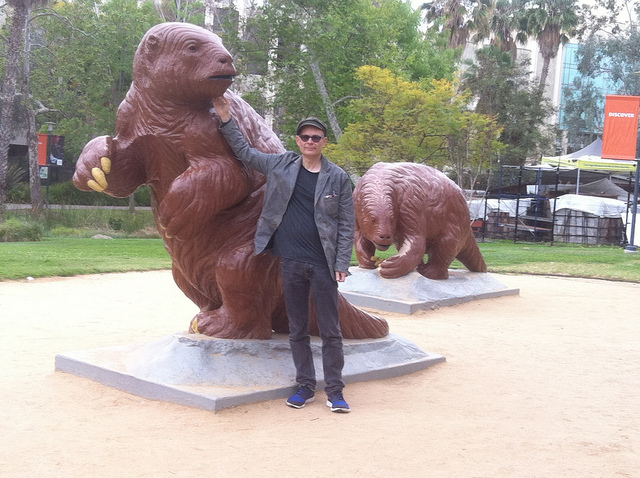 yours truly and the ground sloths
In a still bubbling tar pit encircled by construction fencing, a family replica of gigantic Columbian mammoths replays a pathetic tableau. An adult is hopelessly stuck in the pit, its mouth agape in panic, its trunk frozen between the great curved brackets of its tusks, frantically gesturing to its mate and calf who stand helplessly on shore. The theme of serial entrapment and the futility of instinct gets amplified as soon as one enters the museum, which is packed with reconstructed skeletons and glass cases full of phylogenetically arranged remains, memorializing the legions of hapless creatures who died there over thousands of years, who just couldn’t stop themselves from making the same fatal mistakes over and over, in a senseless and recurring cruelty against which no benevolent god or Walt Disney narrator would intervene to warn ‘Stay out of those pits, yo!’ If only Spielberg had been in charge…
In paleontological terms, the tar pits are what is known as an ‘evolutionary trap.’ These create a stimulus that certain species are unable to resist and the results are often fatal. A contemporary equivalent has been the sad epidemic of dying albatrosses we’ve been seeing on Pacific Islands, their body cavities packed with bits of plastic that they seem programmed to snatch up from the waves and swallow in place of their natural food. Like the victims of La Brea, they just can’t help themselves.
Back at the Tar Pits, the Dire wolf (Canis dirus) seems to have been a particularly slow learner. To date the remains of over four thousand of them have been found there with doubtless many more to come. One of the more impressive displays at the George C. Page is a long, back-lit display, like something out of a high-end shoe store, containing hundreds of Dire wolf skulls, each an embodiment of one individual’s lack of impulse control. It seems that whenever a pack of them came upon an animal in distress in the tar, they would pile right on in on top of it, dooming themselves by their own overly developed killer instincts and susceptibility to peer pressure. The fact that the Dire wolf seems to have been exceptionally competitive, didn’t help matters. Males in areas where there was high population density developed outsized fangs with which to fight each other. It’s hard not to imagine the pack dynamic being a rather savage affair, especially when they chanced upon a bleating animal, trapped in tar. For the Dire wolf, there likely wasn’t a lot of time for second guesses. Though heavier and likely much meaner than their little cousin the coyote (Canis latrans), the Dire wolf failed to survive the Pleistocene, while the coyote still thrives in LA’s hills and canyons, feeding on what it finds in trash cans and snatching up unguarded pets. Though the Tar Pits weren’t the only factor in the Dire wolf’s continent-wide extinction, the evidence of its behaviour at La Brea indicates an inherent inflexibility, which must have been a major handicap in what, at the end of the Pleistocene, was a rapidly shifting set of conditions including changes in climate and the incursion of the first Paleo-Indians into its environment, who competed aggressively with the wolf for prey.
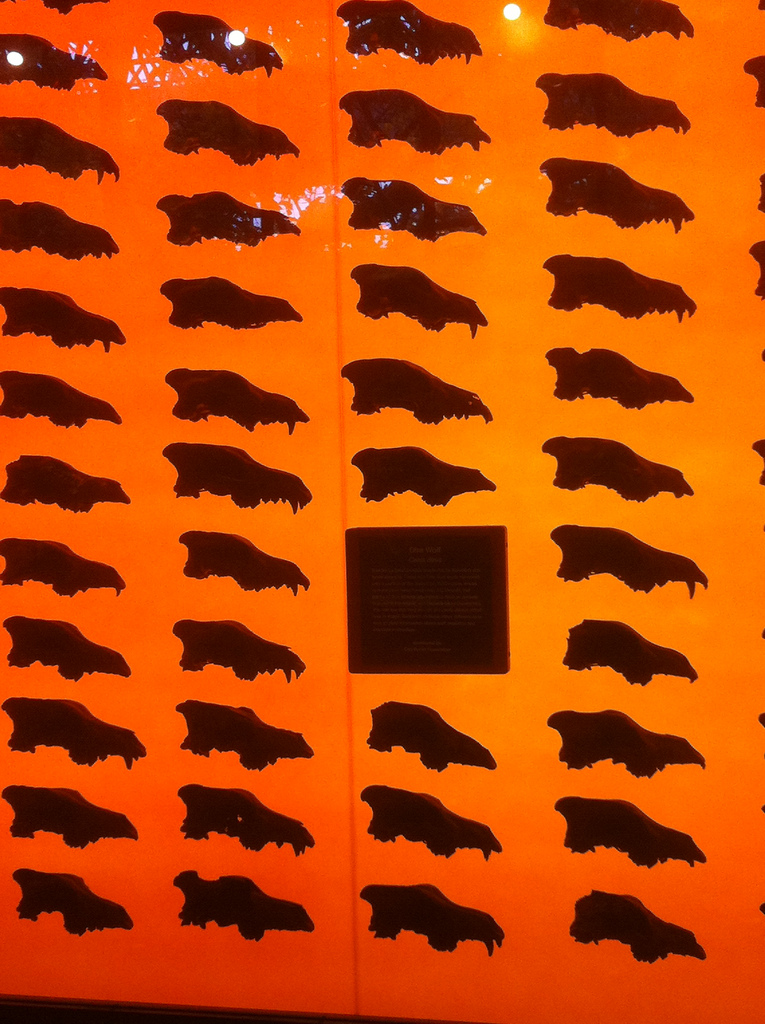 dire wolf skulls Though we may think our species’ ability to show foresight gives us particular resiliency–after all we started out in minuscule numbers, survived an Ice Age and proceeded to take over the world–we find ourselves now under a similar delusion to that which befell those hapless beasts at La Brea. Could it be that in the black, viscous materiality of petroleum we have finally met our match? Though we may think we have mastery over our fate, we seem blind to the possibility that it might be a substance that has control over us…
As an evolutionary trap– a nemesis–petroleum is the perfect agent. It is the very essence of death, a distillate of corpses from untold myriads of prehistoric organisms, which has quietly waited for us beneath the earth. If substances possess their own agency, as Jane Bennett surmises in her (2010) Vibrant Matter, is it so far-fetched to suggest that petroleum is luring us in, manipulating our innate behavioural vulnerabilities to ultimately absorb us into its oozing corpus? Like the sabre-toothed cat and Dire wolf before us, petroleum has exerted its ability to hypnotize, to communicate directly with our vulnerable animality, bypassing our much vaunted capacity for reason and discernment. It’s not that big a leap from the Tar Pits to the Tar Sands…
As happened to the Pleistocene creatures who got stuck in it when they put aside their caution, petroleum–ever protean– has set its exquisite trap for us in the form of a fata morgana, which gives us the illusion of eternally abundant and convenient energy with no long-term consequences. We are probably already in too deep to realize what has happened; that we are becoming petroleum, absorbed by the wily substance to become one with its subterranean deposits.
The Anthropocene might be remembered as a geologically brief period during which our species was allowed an overdraft, a blip during which we extracted a quantity of the black ooze before we had to repay our loan with the highest of interest; our lives, and those of the countless other organisms we took with us after we have made the planet uninhabitable. In so doing, we are offering up billions of putrefying corpses, untold tonnage of petrochemical garbage and entire landscapes of withered vegetation to be re-incorporated into the geologic, where unstoppable tectonic regimes will reprocess it into the mother of all oil fields.
So it is a mistake perhaps to wax too moralistic about our failure to rein in our natural impulsivity, to plan sensibly or imagine a future free from our addiction to this substance. Our connection to it might be too deep, too genetically encoded for us to resist through mere self critique.
Following the logic of the Dire wolf, our own species is competing increasingly viciously for what is (for the geologic moment anyway) a limited resource. The power elites in localities dependent primarily on petroleum production (Russia, Nigeria, Libya and others) have drawn whole societies into animality and impulsivity.
Even Canada, long a role model for liberal democracy, has slid into this petro-brutality. Under the prime ministership of oil-mad Stephen Harper, its government has declared a totalitarian war on scientists who study climate change and associated environmental contamination. The uncomfortable facts they keep bringing up highlight Canada’s abysmal record on these matters, which, aside from being an international embarrassment, threaten to push the usually complacent Canadians into a confrontation with the ecological Real (boring!, depressing!), invoking questions the Harper government is determined not to let us ask. Important and long-standing research facilities and environmental monitoring stations have already been shuttered, their scientists sacked and the scholarly material packed away or even thrown into the garbage. Those few scientists still working have been given STASI style minders, through which all communication with the public must be vetted. They even shadow the scientists at academic conferences to make sure they don’t say anything deemed ‘off message’ to the government’s single-minded agenda.
Yet given that our attraction to petroleum is demonstrably biological, can we really blame the individual oil worker, warlord or myopic Canadian bureaucrat? By doing their part to hasten mass extinction, they are in the service of the long term interest of petroleum itself. By extending its sticky tendrils through a higher dimensional space than most of us are letting ourselves imagine, petroleum assumes the characteristics of what the philosopher Timothy Morton calls a ‘hyperobject,’ an entire set of relationships, interactions agencies and desires of which we are but a small and transient part.
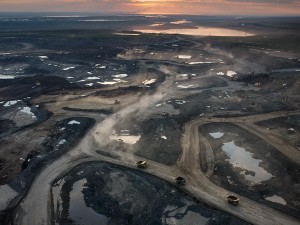 tar sands (via National Geographic)
|
|


